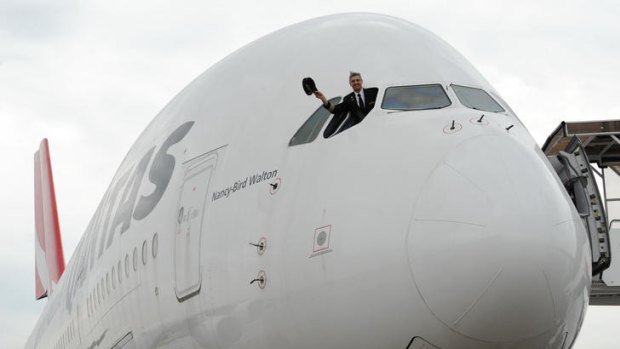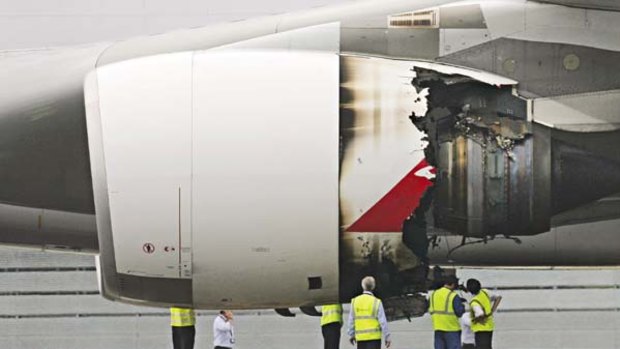
Qantas captain Richard de Crespigny on board the Airbus A380 jet Nancy Bird-Walton before its flight back to Australia.Credit: AFP
Nancy Bird-Walton is home again.
Some 535 days after a mid-air engine explosion over Indonesia, the pride of the Qantas fleet - the plane that chief executive Alan Joyce calls the Flying Kangaroo's flagship - touched down at Sydney's Kingsford Smith Airport at 9.18am (AEST) yesterday.
The Qantas Airbus A380, named after the pioneering Australian aviatrix, has spent the past 16 months in Singapore undergoing repairs following the explosion on November 4, 2010, that investigators later found was caused by a faulty oil pipe.
The repairs, which cost $139 million, involved about 100,000 man hours and the replacement of all four engines. Rigorous flight testing was completed in early April and the plane left Singapore on Saturday night (Singapore time).
In what has been the biggest aviation repair job in living memory, Airbus, Qantas and Singapore Airlines Engineering technicians from around the world have worked on the aircraft for 11 months, utilizing about 40,000 tonnes of tooling and parts.
Some 170 Airbus technicians from eight different nations have been part of the repair team, along with specialists from Qantas and Singapore Airlines Engineering.

The damaged engine of the Nancy Bird-Walton after it made an emergency landing at Changi airport on November 4, 2010.Credit: Reuters
And the parts themselves have come from parts of Asia, as well as France and Europe.
"The aircraft is now back as good as new," Airbus director of customer support and services Derek Blackham said during a media briefing in Singapore on Friday.
"That's the way we planned it."
It has also undergone rigorous testing - both on the ground and during two test flights - prior to being given the all-clear to start carrying passengers again.
On November 4, 2010, the double-decker Qantas A380 was flying over Indonesia when an engine caught fire and exploded due to what investigators later said was a faulty oil pipe.
The "uncontained engine failure" on one of the four Rolls-Royce Trent 900 engines sent debris flying in all directions, piercing the wing, puncturing fuel tanks and damaging some wiring and hydraulics.
Also, parts of the engine landed on the Indonesian island of Batam.
The pilots managed to land the plane safely back at Singapore's Changi Airport without injury to any of the 433 passengers and 26 crew.
As part of the repairs, estimated to cost $139 million and covered by insurance, more than six kilometres of wiring in the aircraft's left wing was replaced.
Qantas manager of maintenance operations Tim Gent said the total cost of the repairs, as well as the cost of having the aircraft on the ground "didn't come close" to its write-off value.
The aircraft was scheduled to re-enter service on April 28, 2012 and bring Qantas's A380 fleet to 12.
The national flag carrier was due to receive two more A380s in 2013, with a further six to come from 2019 onwards.
The head of Qantas's integrated operations centre, Alan Milne, said representatives from engine manufacturer Rolls Royce were offered the opportunity to participate in the media briefing but they declined.
"They are a great business partner of ours," Mr Milne said.
"We do support them and have all the confidence in the world in Rolls-Royce and their engines."
Joining Mr Joyce on the jet's flight to Sydney were pilots Captain Richard de Crespigny and Captain Dave Evans, as well as 16 of the 22 cabin crew from QF32 on November 4, 2010.
There were cheers and tears on board as the plane landed in a foggy Sydney on Sunday morning (AEST) and passed through a water cannon salute on its way to the arrival gate.
Mr Joyce said it was a special moment to have the Nancy Bird-Walton, registration number VH-OQA, back in Australia, given the aircraft was named after such an important figure in this country's aviation history.
It was also the first double-decker superjumbo to join the Qantas fleet, in September 2008.
"It's very emotional," Mr Joyce told AAP as the plane began its descent. "It shouldn't be - it is only an aircraft, as somebody said to me - but I think it is more than an aircraft. It's our reputation, our history.
"Anybody that knew Nancy Bird-Walton knew what an amazing aviation legend she was.
"She was there for the naming of the aircraft, so for us I suppose it was very emotional getting this fixed, getting Qantas's flagship back in the air."
The Nancy Bird-Walton is scheduled to re-enter service on April 28, as QF127 to Hong Kong, and bring Qantas's A380 fleet to 12.
The reporter travelled to Singapore courtesy of Qantas Airways.
AAP
Sign up for the Traveller Deals newsletter
Get exclusive travel deals delivered straight to your inbox. Sign up now.